Just across I-580 from Point Richmond and in clear sight of my home may be Richmond’s best kept secret.
Everybody knows there is a Chevron Refinery there, but no one seems to know anything about the Richmond Technology Center campus, as visually prominent as any group of buildings in Richmond but as obscure as a skunkworks. With the still simmering excitement about bringing Lawrence Berkeley National Laboratory to Richmond, who knew Richmond already hosts an even larger world class research facility on the cutting edge of science brimming over with Ph.D.s?
So I asked Chevron for a tour, which was granted on Friday, March 22. Chevron’s Heather Kulp made the initial arrangements, and since she was out of town, her colleague, Nicole Barber, finalized the arrangemements.
As one would suspect, both security and safety measures were tight. We started with a briefing in the LEED Silver Administration Building, where I met and received presentations from:
- Jeff Hedges, Division Manger, Intergrated Lab Technologies, Process, Analytical & Catalysis Department, Chevron Energy Technology Company
- Jim McGeehan, Consulting Scientist, Engine Oil Technology, Chevron Products Company
- Peter Fuentes-Afflick, Senior Staff Engineer, Fuels Technology & Additives, Downstream Technology, Strategy, Technology & Commercial Integration, Chevron Global Downstream LLC
- Hajid Ahmadi, Ph.D, Manager, Fuels Technology & Additives, Downstream Technology, Strategy, Technology & Commercial Integration, Chevron Global Downstream LLC
The head of Richmond Technology Center, Paul Allinson, was unavailable for the tour. His title is vice-president and general manager, Chevron Energy Technology Company and site director.
The briefing team talked about a long history of innovations in Chevron fuel technology, including Red Crown Aviation Fuel in 1927 that provided the extra efficiency that enabled Lindbergh to cross the Atlantic. In 1941, Chevron developed a submarine diesel fuel that enabled the U.S. to dramatically increase its submarine range in both the Pacific and the Atlantic Oceans.
The Richmond Technology Center has 1.2 million square feet of space in 36 buildings spread over 31 acres. It employees 1,200 people (both employees and contractors), 20% of which are Ph.D.s and 10% of whom live in Richmond. The facility is responsible for about 125 patents each year; over 500 have been granted since 2009 -- 50% of the total patents filed by Chevron.
The one statistic I didn’t get was the total payroll, but it must be well over $100 million annually.
The campus includes 30 highly intricate scale modeled pilot plants for process research and another 185 bench-scale plants.
The Technology Center is essentially a research resource for Chevron operations worldwide and is involved in not just squeezing every last mile from fuels and lubricants but also in emerging technologies, including ocean energy, enhanced geothermal, energy storage, energy recovery, solar to thermal energy, biofuels, solar PV, wind and fuel cells. One of the pilot plants recently produced a 100 percent bio-derived jet fuel based on a species of mustard seed.
A lot of the research at the Richmond Technology Center is directed at reducing emissions of both gasoline and diesel fuel and reducing deposits in engines that affect efficiency, hence a significant emphasis on proprietary additives. There is also a lot of work on lubricating oils, since Chevron is the source of all the base lubrication products marketed on the west coast.
Employees of the Richmond Technology Center are active in the community, particularly in Project SEED, which has interns in the labs, and in 1,127 volunteers that counted 3,300 hours for 133 projects in Richmond in 2012.
No one from Chevron was able to say exactly why the Richmond Technology Center has had such a low profile all these years, but they committed that change would be coming, and that there would be opportunities for the community to visit the facility in the near future and learn more about what goes on there.
As a comparison, the Richmond Technology Center facility is both larger and employs more people that the LBNL campus that may open in 2017.
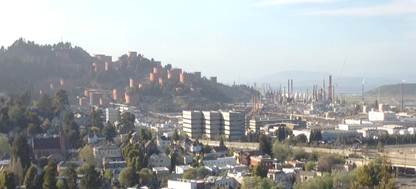
Above, the Richmond Technology Center as seen from my home in Point Richmond
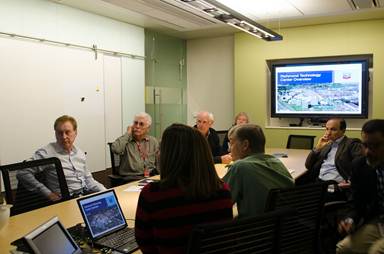
Introductory briefing
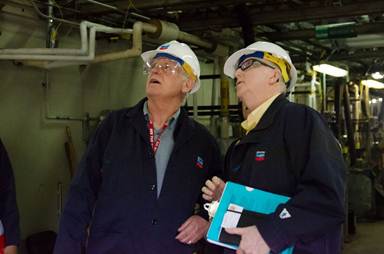
The pilot plant lab building
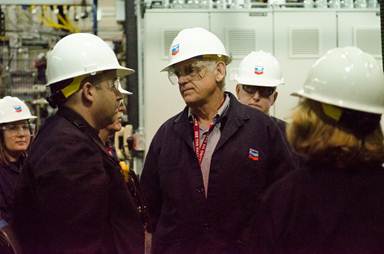
Viewing a pilot plant
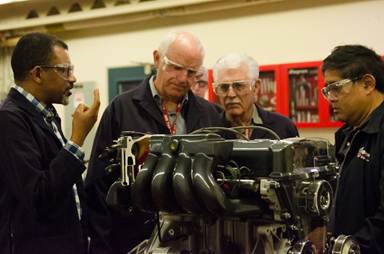
The engine lab, where fuels and lubricants are tested on a variety of engines
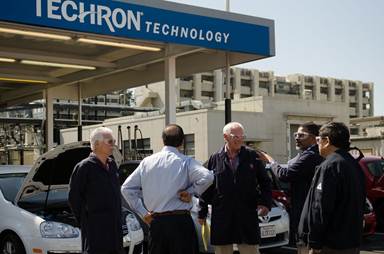
The dynamometer facility – a treadmill for cars
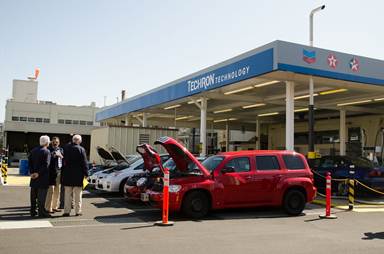
Late model cars are put through 50,000 mile tests at the dynamometer facility
|

